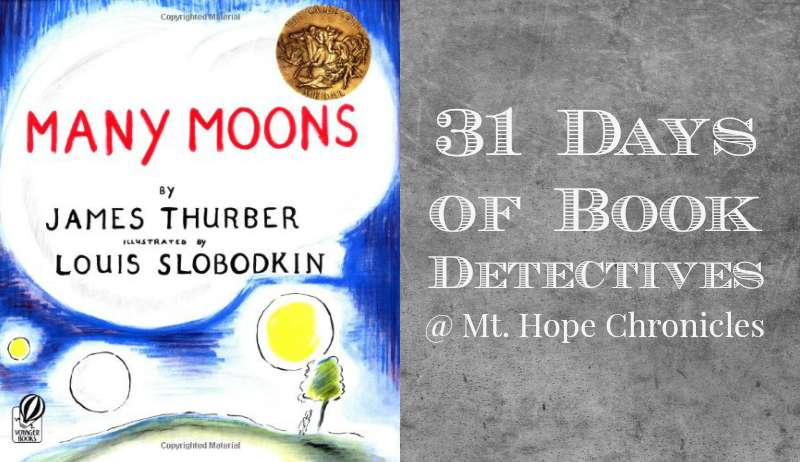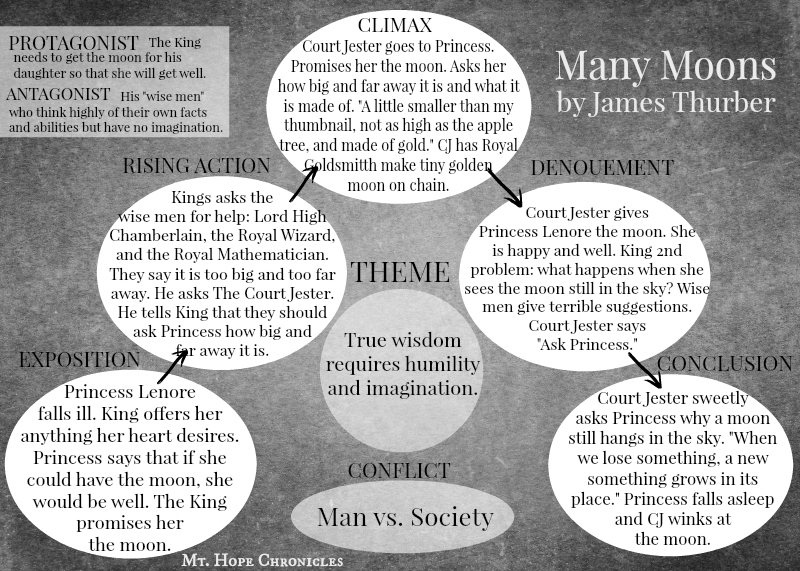[Click here to read other posts in the series.]
If there is another children’s book author who loves words as much as William Steig, it must be James Thurber. His books read like an ode to language, particularly his short chapter book The Wonderful O. I will be sharing notes from another short chapter book by Thurber, The 13 Clocks, later in this series. Thurber’s life story is quite interesting, particularly the William Tell story (which I shared with my wide-eyed Book Detectives). He is possibly most famous for his very short story The Secret Life of Walter Mitty (click on link to read the whole story), which was published in The New Yorker in 1939 and recently turned into a full-length movie (both fantastic discussion material for slightly older students).
If you are new to James Thurber, start with the picture book Many Moons, published in 1943. It is a longer picture book easily enjoyed by older students and adults due to the humor and the subtly profound ideas. It’s also a blast to read aloud. Many Moons is a great choice if you are using picture books with middle school or high school students to introduce them to literary analysis. Yes, it’s a fairytale about a princess, but it’s also great fun. The conflict and the theme are more complex, as well. I’m still not sure I have it “right.”
“The moon?” exclaimed the Lord High Chamberlain, his eyes widening. This made him look four times as wise as he really was.
“Yes, the moon,” said the King. “M-o-o-n, moon. Get it tonight, tomorrow at the latest.”
The Lord High Chamberlain wiped his forehead with a handkerchief and then blew his nose loudly. “I have got a great many things for you in my time, your Majesty,” he said. “It just happens that I have with me a list of the things I have got for you in my time.” He pulled a long scroll of parchment out of his pocket. “Let me see, now.” He glanced at this list, frowning. “I have got ivory, apes, and peacocks, rubies, opals, and emeralds, black orchids, pink elephants, and blue poodles, gold bugs, scarabs, and flies in amber, hummingbirds’ tongues, angels’ feathers, and unicorns’ horns, giants, midgets, and mermaids, frankincense, ambergris, and myrrh, troubadors, minstrels, and dancing women, a pound of butter, two dozen eggs, and a sack of sugar—sorry, my wife wrote that in there.”
“I don’t remember any blue poodles,” said the King.
“It says blue poodles right here on the list, and they are checked off with a little check mark,” said the Lord High Chamberlain…
“Never mind the blue poodles,” said the King. “What I want now is the moon.”
“…[T]he moon is out of the question. It is 35,000 miles away and it is bigger than the room the Princess lies in. Furthermore, it is made of molten copper. I cannot get the moon for you. Blue poodles, yes; the moon, no.”
Crime Scene [Setting]
Where?
A kingdom by the sea
Fairytale world
When?
“Once upon a time…”
The story happens over the course of a day or two.
Suspects [Characters]
Who?
Princess Lenore—girl, ten years old, going on eleven; likes raspberry tarts; wise
King—demanding, loves his daughter
Royal Physician—couldn’t heal the princess
Lord High Chamberlain—large, fat man; wore thick glasses; good at getting things but not very wise
Royal Wizard—little, thin man with a long face; wore a high red peaked hat covered with silver stars and a blue robe; good at magic but not very wise
Royal Mathematician—bald-headed, nearsighted man, with a skullcap on his head and a pencil behind each ear; wore a black suit with white numbers on it; good with facts but not very wise
Royal Goldsmith—talented with gold, but no imagination
Court Jester—man wearing motley and cap and bells; sat at the foot of the throne; “What can I do for you, your Majesty?”; did not look wise but was; humble; kind
[Older kids could possibly dig deeper at the end of the discussion and consider whether the characters (particularly the Chamberlain, Wizard, and Mathematician) each represent a larger idea.]
[I was incorrect about at least one thing in the chart above. The King did not ask for the Court Jester to help him get the moon for his daughter; he only asked for comfort. And that’s important!]
Other possible themes/morals:
Arrogant, self-important government, superstition, facts, and even productivity (and medicine?) fail when child-like understanding and faith is needed.
Wisdom can be found in unexpected places and in unexpected people.
Looks can be deceiving.



Thurber is from my home town (I even own a Thurber Bobblehead!), but we haven't read any yet. I guess I thought it was all for older children. Have to look into this.
ReplyDeleteVery much enjoying the series ... lots of books we don't know!
Oh, you have to read Many Moons and The 13 Clocks at least! And The Secret Life of Walter Mitty for you. :)
ReplyDeleteI tried to pick books that were possibly less familiar and not obvious. Glad some are new to you!